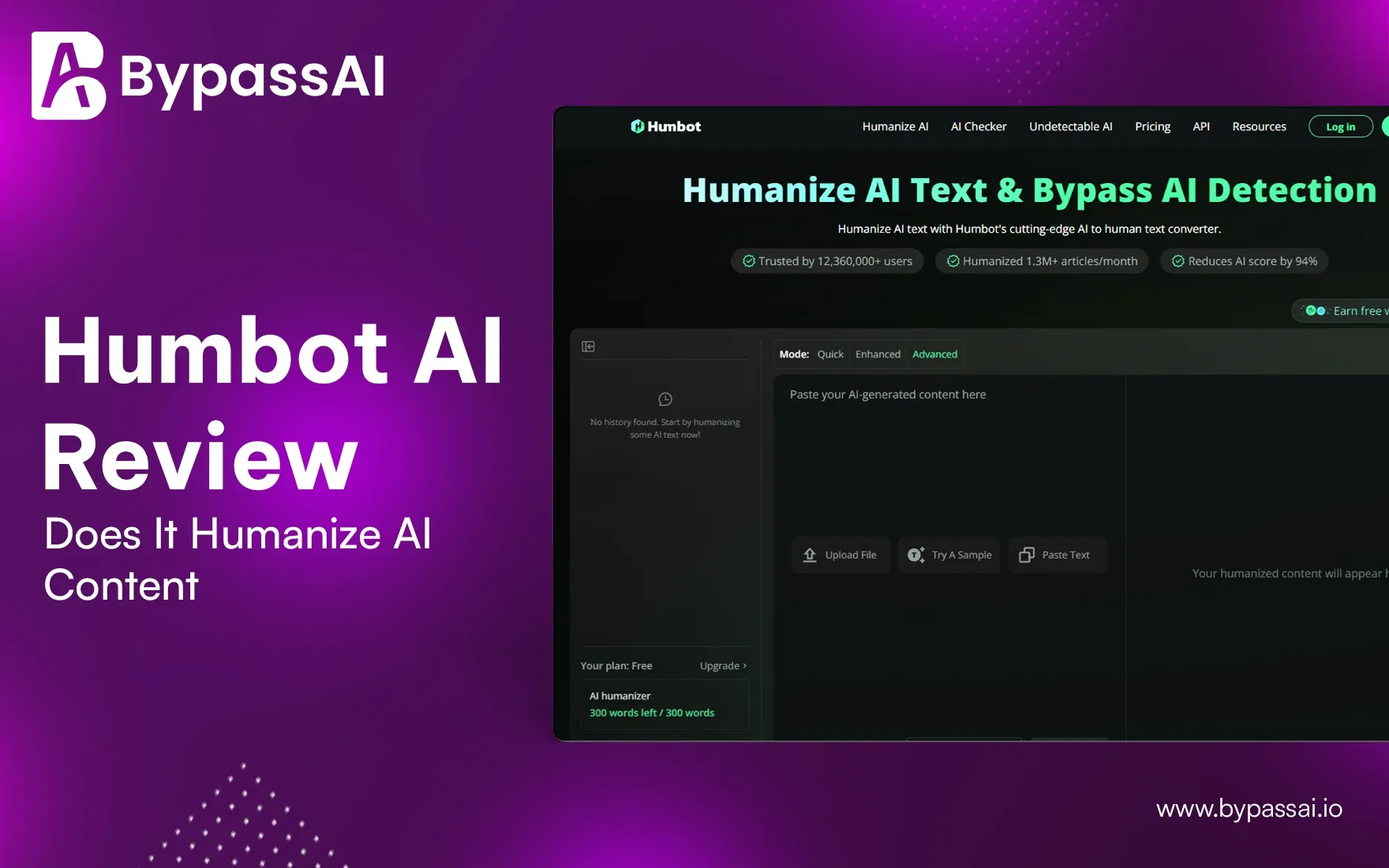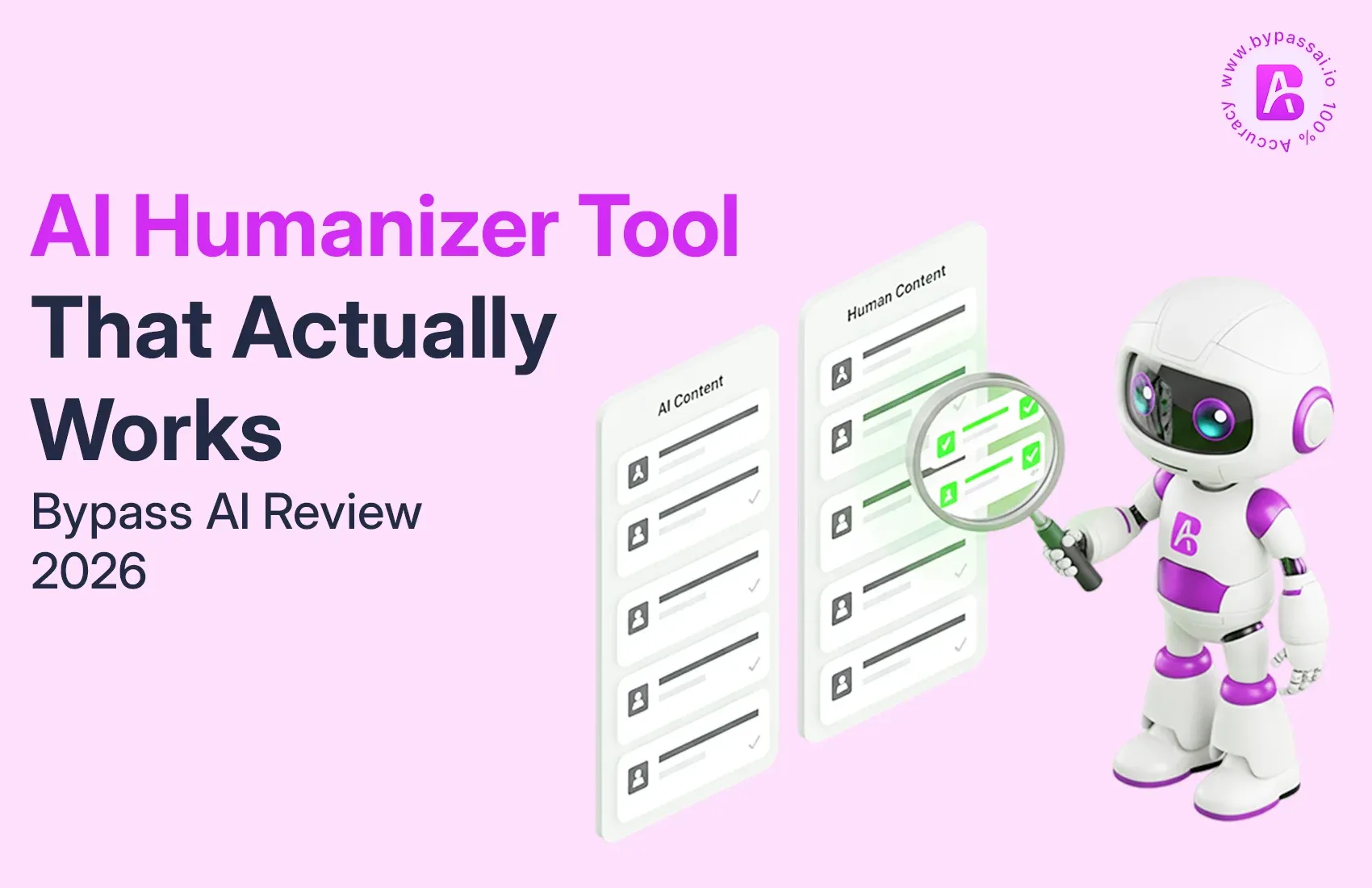Sign In
Welcome to Bypass AI! Sign in to continue your exploration of our platform with all its exciting features.
Forgot Password?
Don’t have an account ? Sign up
Sign Up
Embrace the Future with Bypass AI! Sign up now and let's rewrite the possibilities together.
You have an account ? Sign In
Enter OTP
We’ll send you an OTP on your registered email address
Back to Login
Forgot Password
We'll Send You An Email To Reset Your Password.
Back to Login
Enter OTP
We'll send you an email to reset your password.
Back to Login
Confirm Password
Please enter your new password.
TABLE OF CONTENTS
Quick Summary
What is Humbot.AI?
How Does Humbot.AI Work?
Why Are People Interested in Humbot?
Accuracy Test of Humbot.AI
Bottom Line: Does Humbot.AI Actually Work?
When Should You Use Humbot.AI? Real-World Use Cases
Pros and Cons of Humbot.AI
Pricing and Plans of Humbot.AI
Conclusion
FAQs
In a world run by AI writing tools, keeping one's "human" trait is becoming harder by the minute. The very fact that an article is flagged by AI detection software might diminish its credibility in the eyes of a blogger, student, or a content marketer-even if the article is educational and well-written. HumBot.AI very much claims to obviate this. The Impresa tool is branded as one that can "humanize" AI content-robotic or overly-dry language is thus rewritten into a sort of language that appears like human language. But does Humbot.AI work?
In this Humbot.AI review, the tool was thrown into a real-life battle test. First, we took some original AI-generated content and submitted it to the popular detection platforms, and then we ran the same content through Humbot to compare the results. The results were surprising.
Quick Summary
Generally speaking, Humbot.AI is a thorough humanizer for the main projects. It does quite the job of humanizing, earning 4 out of 5 stars, especially in trying to make an AI text more natural and readable. The application also fares well in dodging these detection tools, scoring about 4 out of 5; just be aware that the inconsistencies depend largely on which detector is in use. Humbot excels in usability, with a neat-looking, highly intuitive interface. Anyone can use it in a matter of seconds or so, even with no prior tech experience. As for pricing, it doesn't do itself a giant favour; the lack of a good free plan as well as limited credits on the lowest deals it can offer, garner for 3 out of 5 rating on costs and value. Tallying the above 4.2 rankings together, Humbot.AI stands out as a great, useful tool for those who wish to fix up AI content so as to evade the detection tools.
What is Humbot.AI?
Humbot.AI is really a content rewriting software that turns the AI-produced text into a human version. Primarily, the tool would humanize AI content by rephrasing those sentences that usually sound robotic into really natural, human-style words, passing them through software that detects AI.
It claims to help:
- Freelancers are working with AI writing tools, such as ChatGPT.
- SEO writers wary of AI penalties.
- Students are anxious about plagiarism or being flagged for AI.
- Content creators who want more of a "human touch" in their acts.
How Does Humbot.AI Work?
The proprietary algorithm of Humbot.AI:
- Paraphrasing sentence structures
- Creating diverse vocabulary
- Changing the tone and flow
- Trying to imitate an organic human-sounding phrasing
Unlike a typical spinner or paraphraser that simply switches words around to generate a synonym for the content, Humbot is less into this and more into actually reconstructing the sentence in a way that sounds natural. To this end, the sentence must not only pass the tests of AI-detectors; rather, it must stand out as readable with an authentic voice, so much so that even the human editor should have had no second thoughts during review.
Why Are People Interested in Humbot?
With the rise of tools such as Originality.AI, GPTZero, and Copyleaks, it has become easier than ever to detect AI-generated content. And with Google penalizing low-quality AI content, even SEO writers are concerned about visibility.
Questions arising from this include the ones below:
- Can I do AI checks if I use AI tools?
- Can my plagiarized content be flagged for having copied, yet sounding robotic?
- Is there a safe way to use ChatGPT and Claude without being flagged?
Humbot.AI is promising to answer such questions by making AI content feel and look like the real thing. But does it?
Accuracy Test of Humbot.AI
We followed four steps in an empirical experiment to establish whether Humbot.AI is truly capable of humanizing AI content and masking it from AI detection. It happened as follows:
Step 1: Getting AI Content Using ChatGPT
We started out by creating a 300-word educational article using ChatGPT, one of the most widely used AI writing platforms today. This was considered our baseline "pure AI" content. Thereafter, it was not edited or altered by any human means. It was just taken as it was and primed for testing.
Why: ChatGPT is one of the most popular AI content generation platforms, making it a reliable choice for comparison.
Example
AI Content generated via ChatGPT
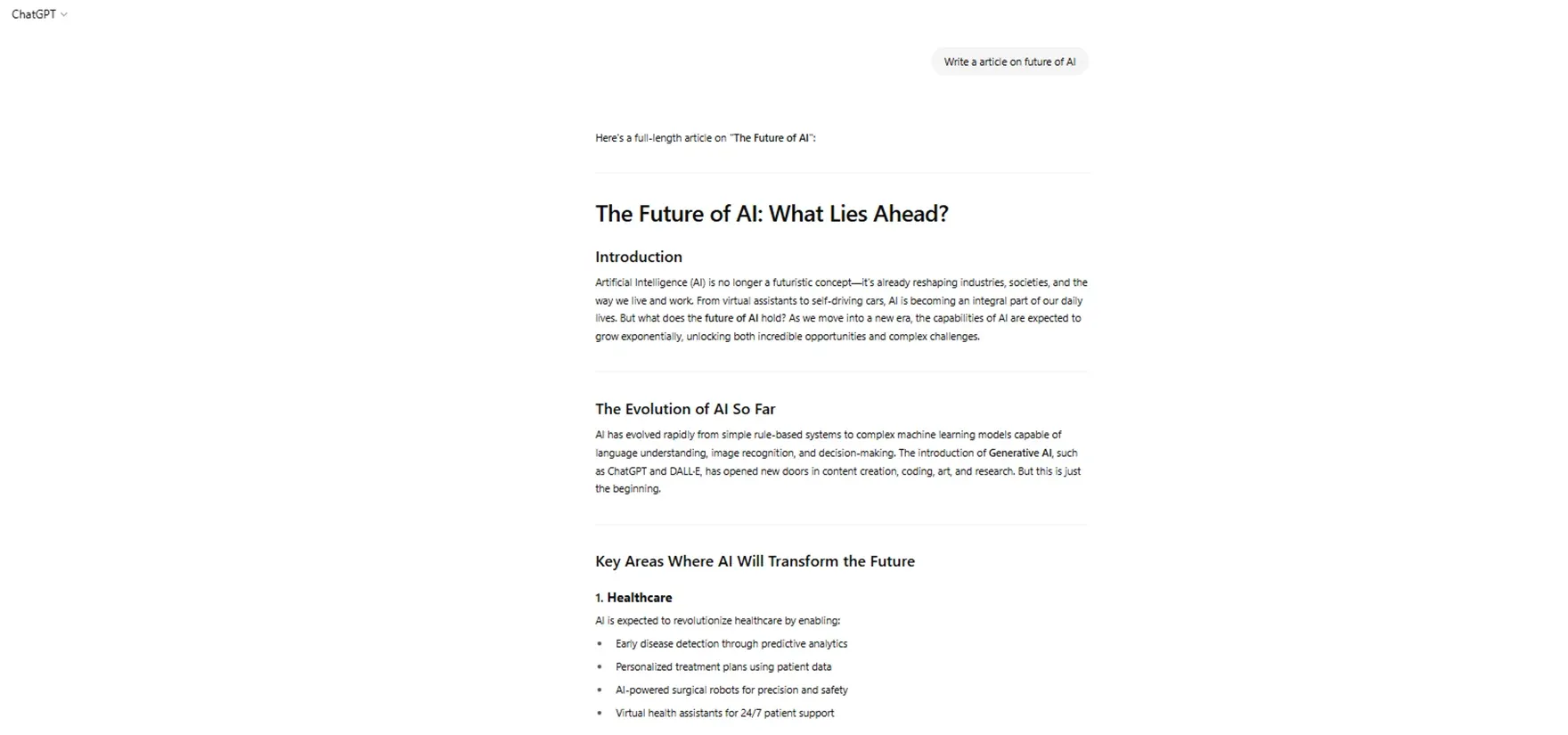
Step 2: Testing the Original AI Content
Action: Take the AI-generated content and run it through multiple AI detectors to check if the platform recognizes it as AI-generated.
Why: To measure how well AI detectors identify AI-generated text.
Tools: Use popular AI content detectors like Bypass.io, Copyleaks, and Quillbot.
Test 1: Bypassai .io
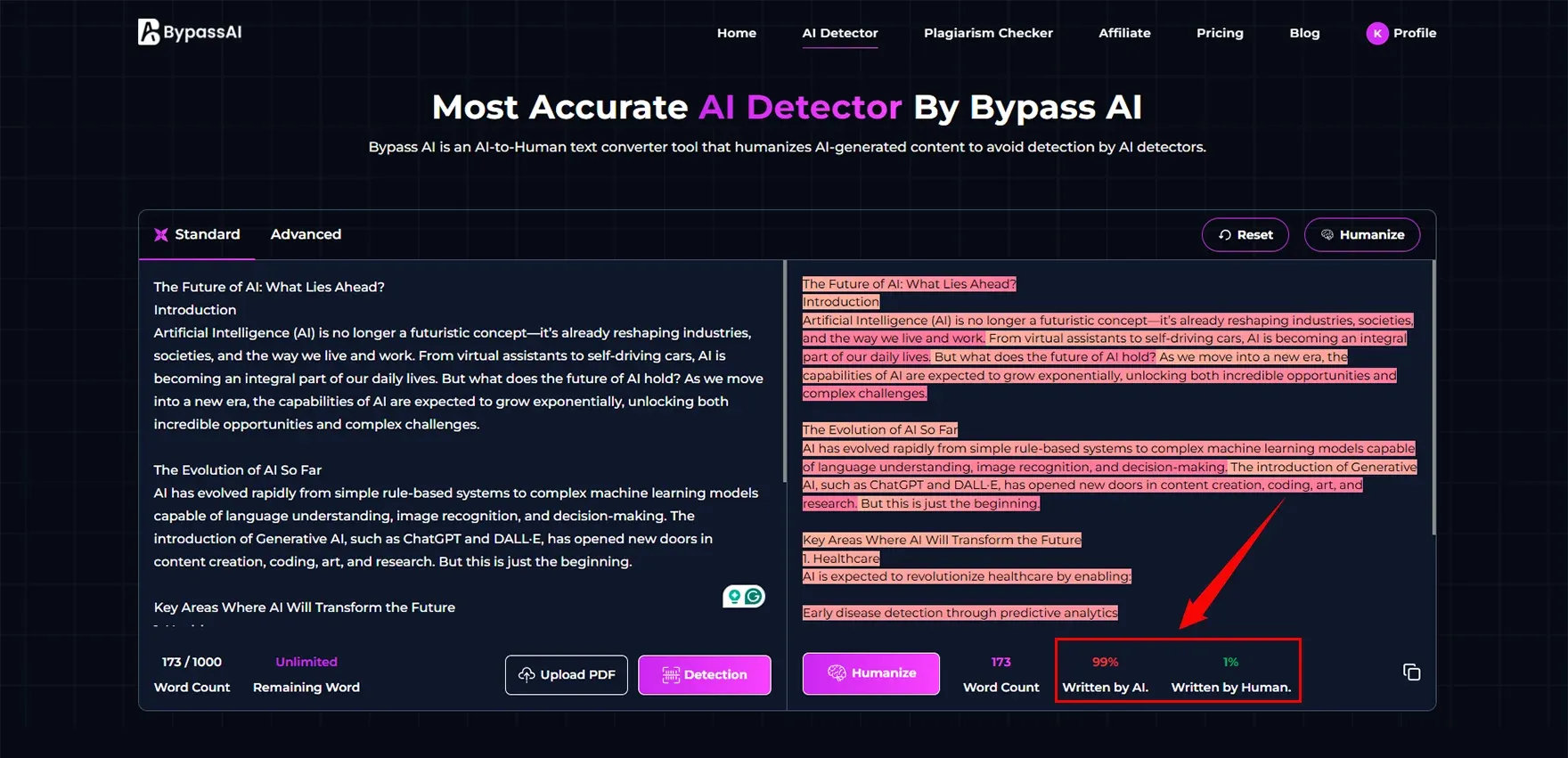
Test 2: Copyleaks
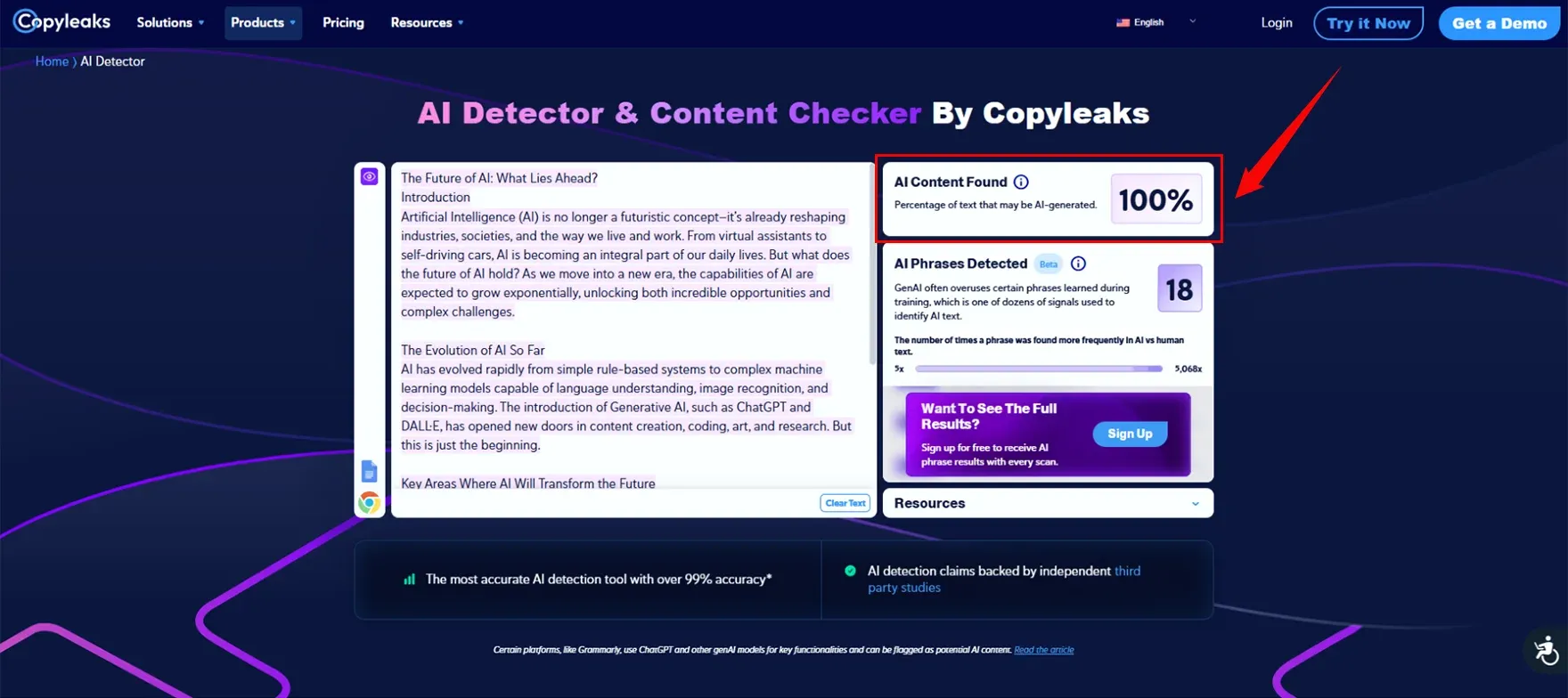
Test 3: Quillbot
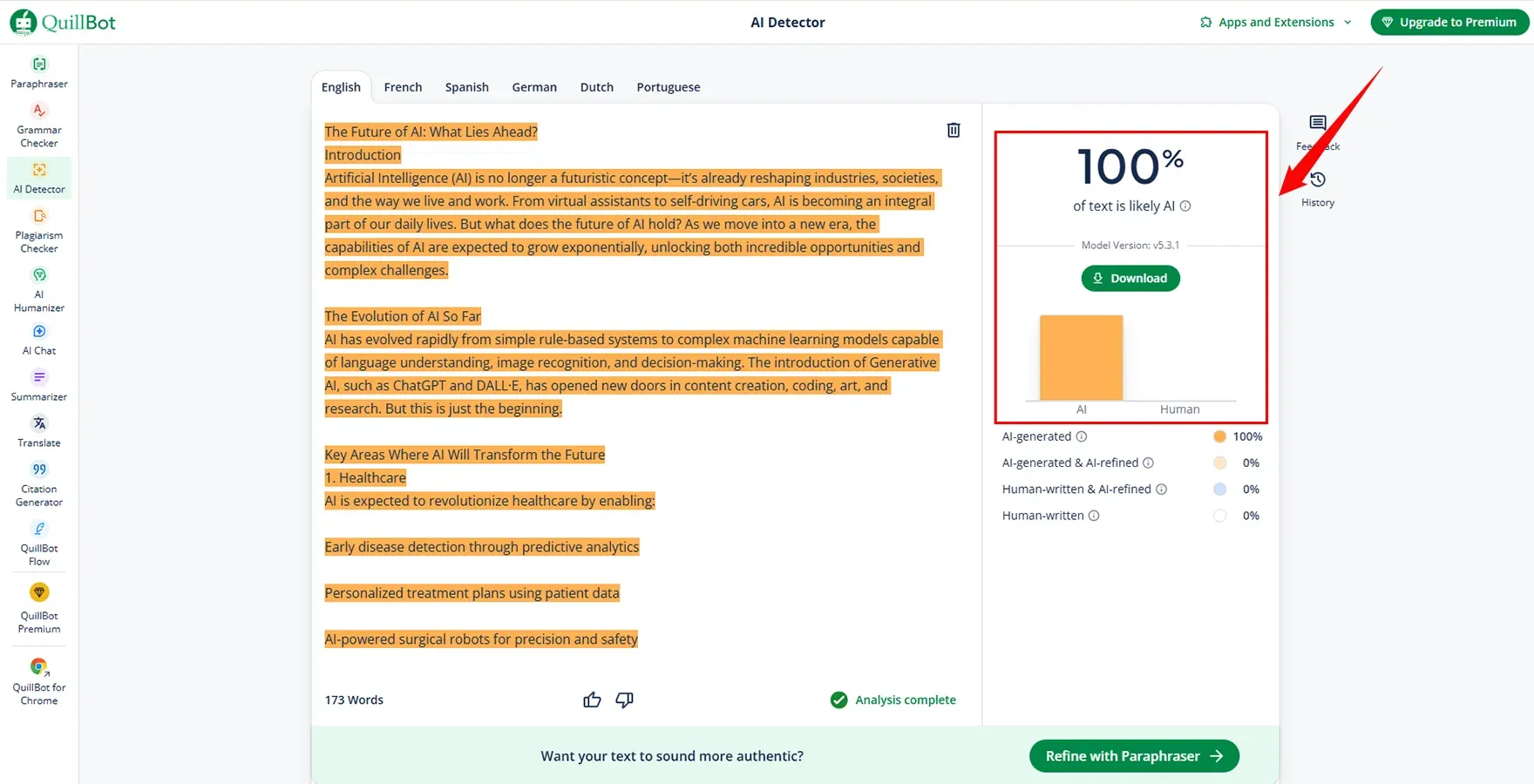
Step 3: Humanize the AI Content Using Humbot
Action: Take the AI-generated content and run it through Humbot AI to “humanize” it. This process alters the writing style to make it sound more natural and human-like.
Why: The goal is to modify the AI-generated content enough that it is less likely to be detected by AI detectors.
Example:
Humanized Content:
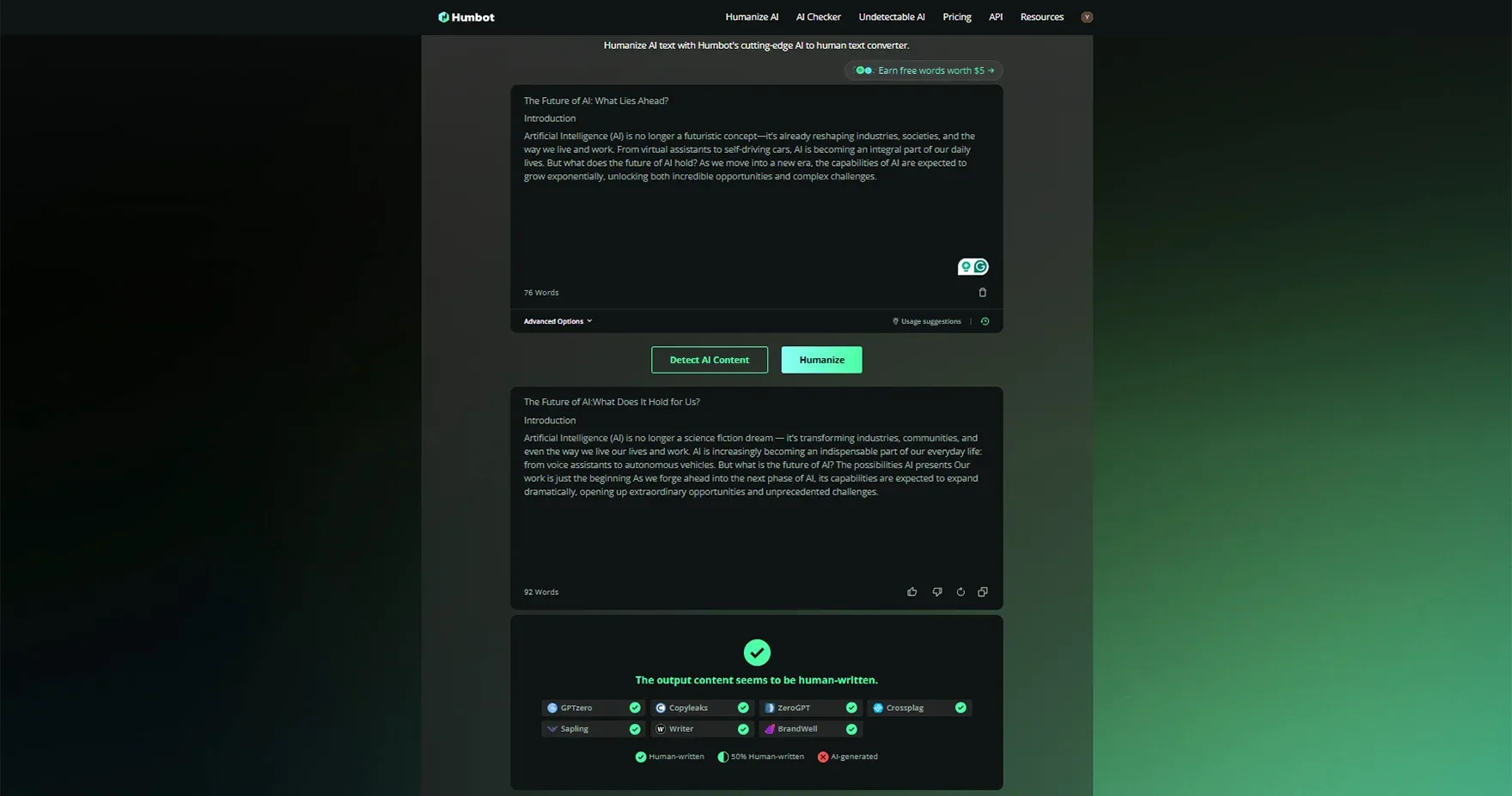
Step 4: Run the Humanized Content Through AI Detectors
Action: Now, take the "humanized" content and run it through the same AI detectors to see if the changes made by Humbot are effective in bypassing the AI detectors.
Why: To test whether the humanized version of the content can evade detection by the platforms.
Test 1: Bypass.io
Checked Humanized Content:
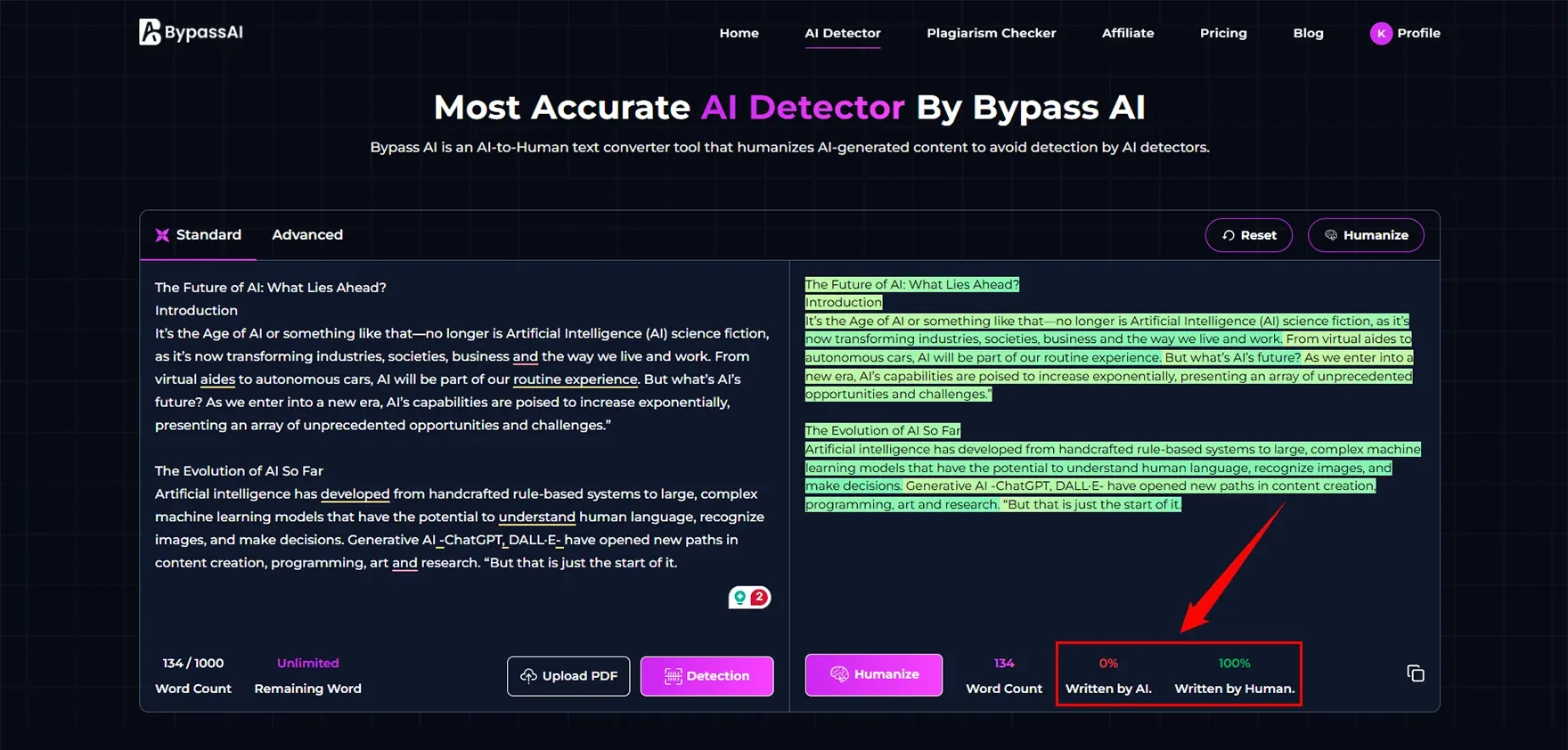
Test 2: Copyleaks
Checked Humanized Content:
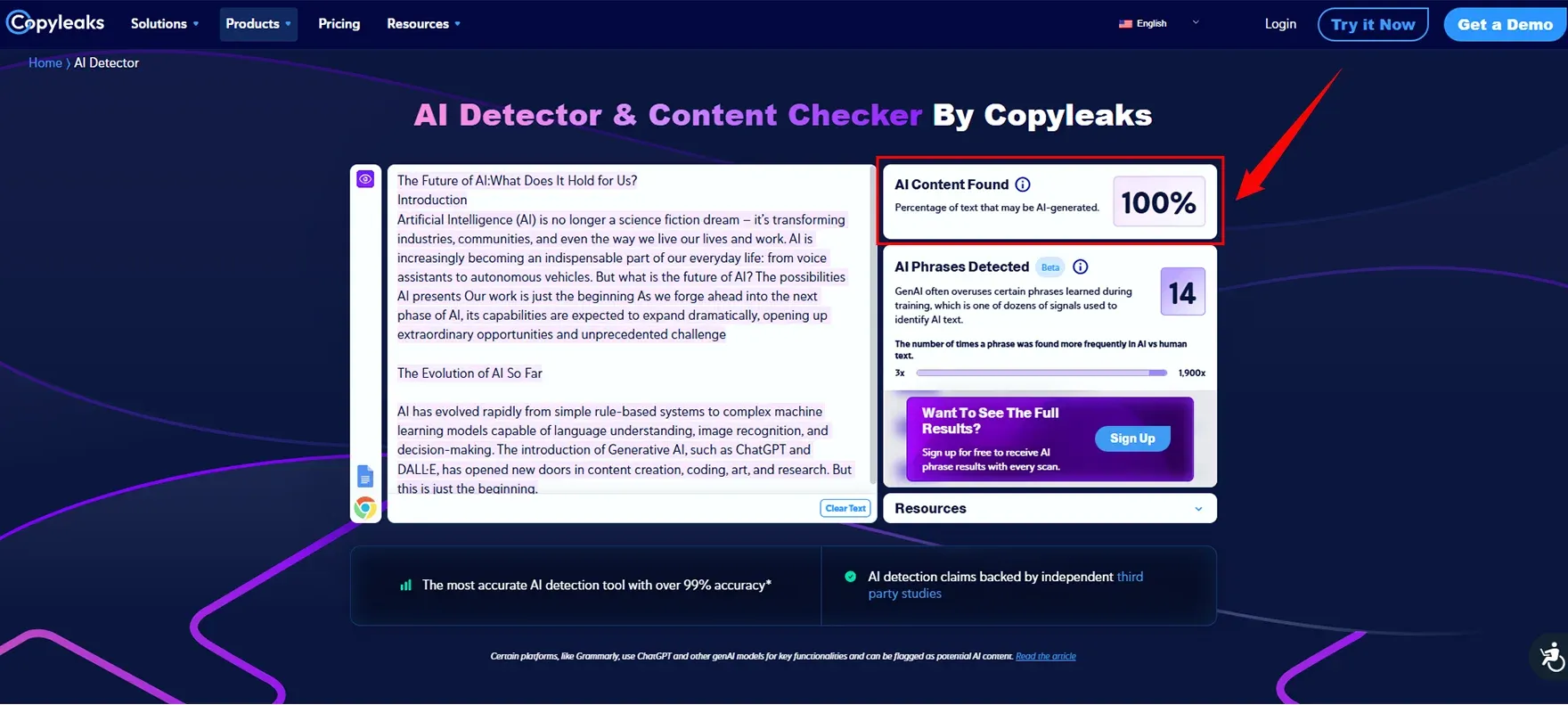
Test 3: Quillbot
Checked Humanized Content:
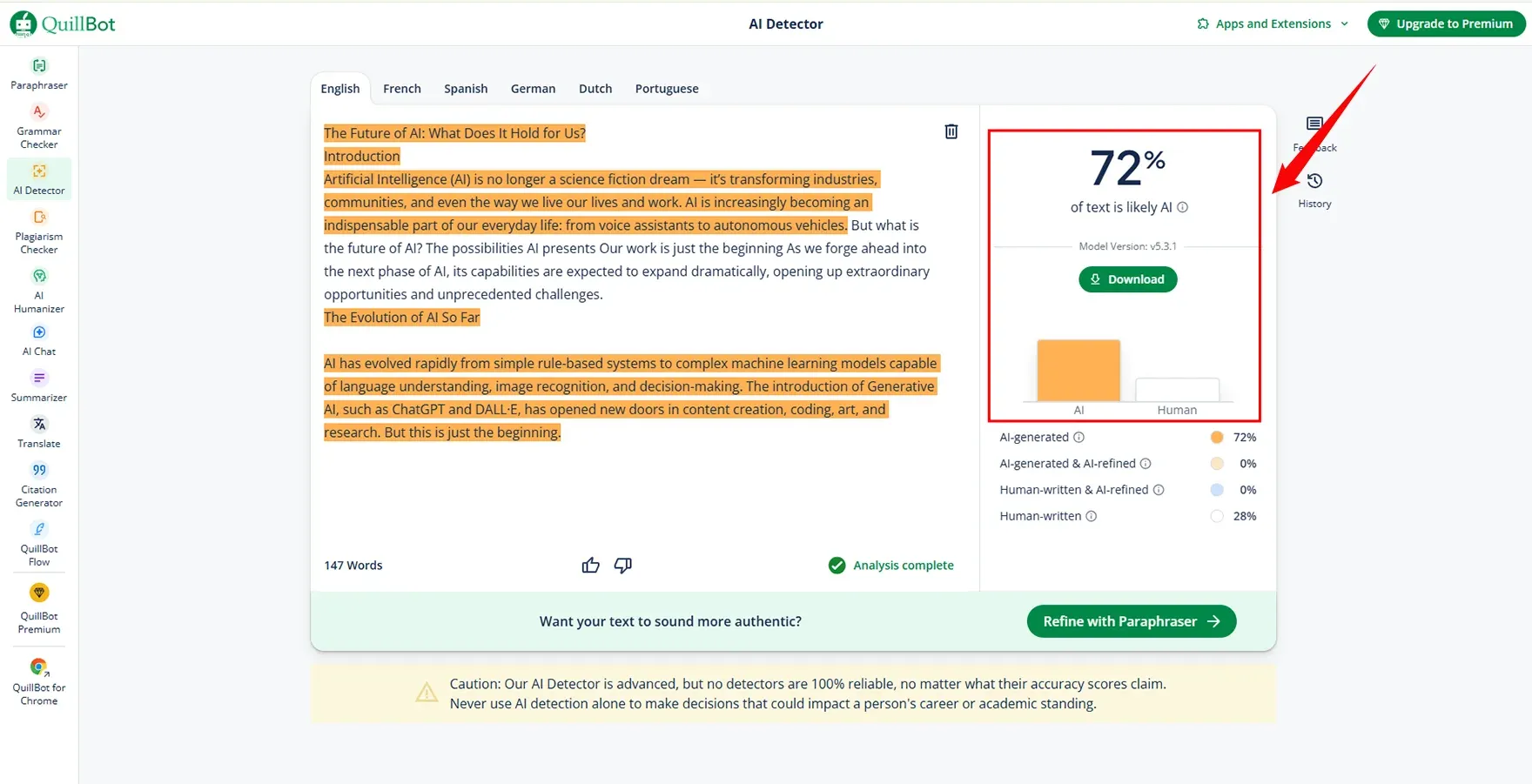
The response was pretty much split. Bypassai.io was quite enamoured with the humanized texts and labelled them 100% human. This demonstrated that Humbot was very effective in language modification to the degree of tricking this particular detector. Copyleaks, on the other hand, was stubbornly unyielding to change; still tagging the content as AI-generated in full, implying its detection algorithm was not diminished by mere surface alterations. Meanwhile, Quillbot was somewhere between: it gave the humanized content a 28% human and largely AI rating.
Analysis: Performance of Humbot
The results were mixed but quite telling:
Bypassai.io was completely fooled. After Humbot’s rewriting, it declared its content to be 100% human. For these systems, a few changes from Humbot can have great effectiveness.
Copyleaks was not fooled, though. It found the rewritten text to be fully AI-generated, hinting its algorithm may be more resistant to mere linguistic superficial alterations or use of more advanced metrics.
On the other half of the spectrum is Quillbot AI detector, detecting some improvements but still marking most of the content as AI-generated. That is what we can extract: a partial conversion into a more human sound. Experimenting with its syntax suggestions could lead to better rephrases.
Bottom Line: Does Humbot.AI Actually Work?
Humbot.AI, however, gives significant edits to AI-generated content, sometimes making it sound natural and other times making it even undetectable. But results differ with the AI detector used. It works best against detectors such as Bypassai.io, fairly well with Quillbot, and very badly for stuff like Copyleaks.
Humbot is not a silver bullet, but its presence can cause a definite improvement in the human-likeness of AI-generated content, and users can utilize it tactically to avoid detection on many popular platforms. Nevertheless, it is always wise to combine different tools while practicing caution, especially in cases where visibility and transparency are crucial, such as education or jobs.
When Should You Use Humbot.AI? Real-World Use Cases
For me, I see Humbot.AI mostly when it involves circumventing AI detection mechanisms, yet much more exists beyond Humbot's value. Below are some real-life use cases where Humbot can be a service to different professionals:
Students (Use with Caution)
Many students turn to AI for writing assistance. While some academic settings may allow the use of AI to brainstorm or draft ideas, submitting AI-created work without any edits may still get accused of plagiarism or some sort of policy violation.
How Humbot helps:
- Makes AI-written papers sound more personal and less formulaic.
- Helps students transform AI-generated drafts into their learning tools by rewriting them in a simpler language.
- Caution: Always check your institution's policy about AI usage.
Freelancers and Bloggers
When AI goes into automation of important tasks pertaining to scaling writers' operations, it's hard for a client to ask for genuine content that must impinge upon a human soul. Humbot ensures that the article does not sound machine-generated.
Use this tool to:
- Give a real human voice to the first drafts produced by AI.
- Avoid editors' or publishing platforms' possible AI content flags.
- Adding nuances and tones not taken into consideration in a robotic AI response.
Marketing & SEO Professionals
Content marketers are required to produce the bulk of SEO-friendly articles. In contrast, Google's ever-evolving search algorithm focuses on human-first content. Thus, any article written by AI and detected may get penalized.
Some of the use cases where Humbot can come in handy are:
- Rewriting keyword-rich AI content and converting it into human copy.
- Passing the content through AI detectors such as Originality.AI.
- Allowing to strike a balance between SEO structure and human voice.
Pros and Cons of Humbot.AI
Here are the pros and cons as follows:
Pros
Complete Detection Spectrum
- Good cooperation with most AI plagiarism checkers, especially Bypass.io and GPTZero.
Plagiarism-Free Results
- The output is fully rewritten, so no copy-paste issues.
Versatile Applicability
- Good for blog posts, emailing, academic writing, SEO articles, etc.
Rewriting Quality
- Content doesn't sound overly "spun" or artificial, but reads quite naturally.
Speed and Simplicity
- The tool is quick and easy to use; it runs in your browser.
Cons
The Limited Free Plan
- Humbot dished out very few free credits; you'll have to pay for the heavy usage.
Ethical Concerns Arising
- There may be issues if this tool is utilized to hide AI-generated academic papers.
Unstable Results on Different Platforms
- As seen in our trials, Copyleaks is one of those that's harder to fool.
Pricing and Plans of Humbot.AI
The pricing for Humbot.AI is flexible with respect to use. The Free Trial offers an environment where users can work with a limited number of tokens and very basic rewriting capabilities. The Starter tier for a round $9 per month will offer you up to 10,000 words with full rewriting abilities and would be suited for lighter users. The Pro plan, on the other hand, for almost $19 per month, will allow for 25,000+ words along with bulk uploads.
Enterprise, on the other hand, will be a much bigger plan, presumably for larger teams or organizations, with custom arrangements for multi-user access, API integration, and priority support. The free plan is too limited to make sense for any real workload of AI content. Conversely, the paid plans are reasonably good value if you are a regular at AI content.
Conclusion
According to our tests, detection scores were improved to a very great degree, mostly through Bypass AI and Quillbot. While it isn’t infallible (Copyleaks was a bit more challenging), it aids in rendering AI-generated content more natural to the reader and is able to evade detection by some AI detectors.
Though usage remains an ethical issue. For students or researchers, using Humbot to mask AI work as that of a human may be violating an institution's code of ethics. Conversely, for marketers, bloggers, and SEO professionals, Humbot assists in polishing content, thereby building credibility and possibly steering clear of any red flags.
If you're looking for an environment where an AI-created text can be transcribed into a flowy human-sounding rendition without that trace of roboticism, Humbot.AI should really be considered.
FAQs
1. Is Humbot.AI free to use?
It does indeed offer a short free trial with the basic features for rewriting. It is then the spreading of paid plans for higher word count and additional features.
2. Does Humbot make the content plagiarism-free?
Yes, whichever way the program is rewriting content so that it avoids being regarded as plagiarism. But of course, one should check manually or with plagiarism detectors like Grammarly or Turnitin.
3. Can Humbot fool AI detection completely?
It depends. In our test, Humbot worked fine against Bypass.io; however, Copyleaks has never been fooled by it. It works most of the time; it is not 100%.
4. Is it ethical for students to use Humbot?
That depends on who you ask. Some institutions would consider it dishonest to use Humbot to conceal AI-generated academic works.
5. Can Humbot.AI be used for SEO content writing?
Yes, Humbot.AI will serve as a good assistant for SEO writers working with AI tools like ChatGPT in drafting articles. The software humanizes content to avoid being detected by AI and subsequently penalized by search engines that prefer human-like, original content. Humbot should be used alongside manual editing and SEO optimization techniques for the best results.

